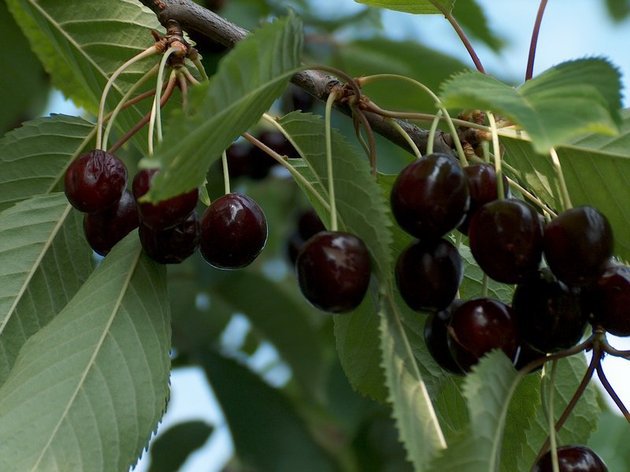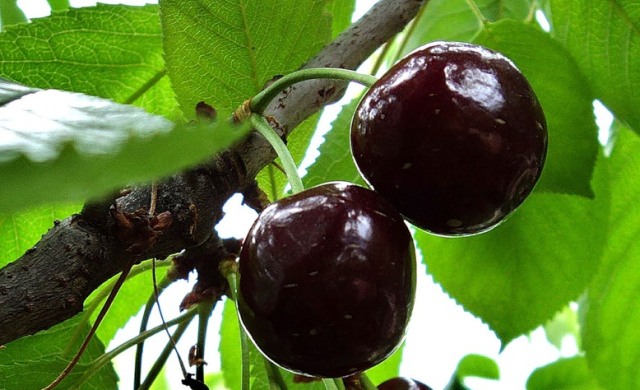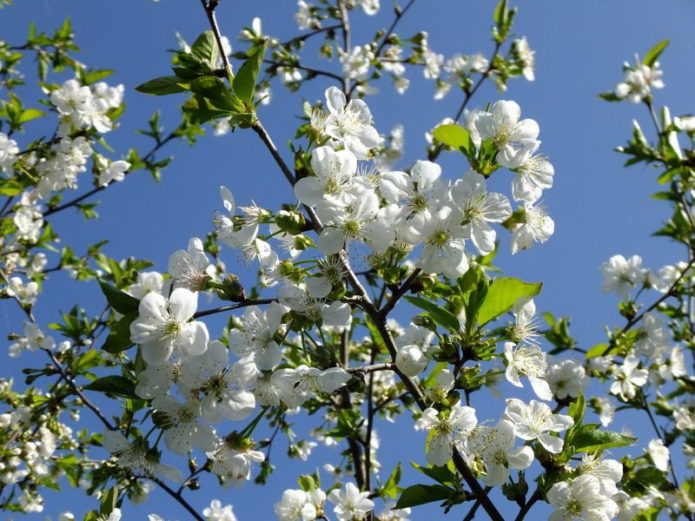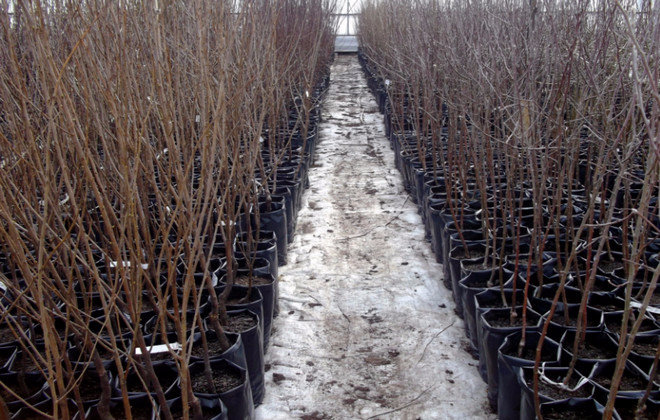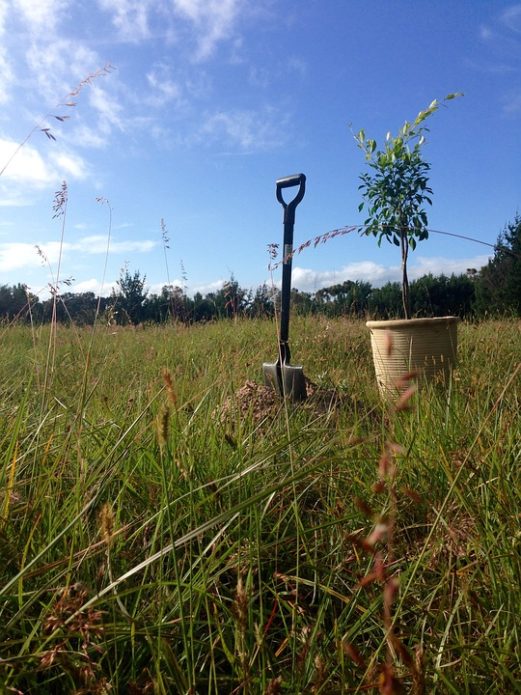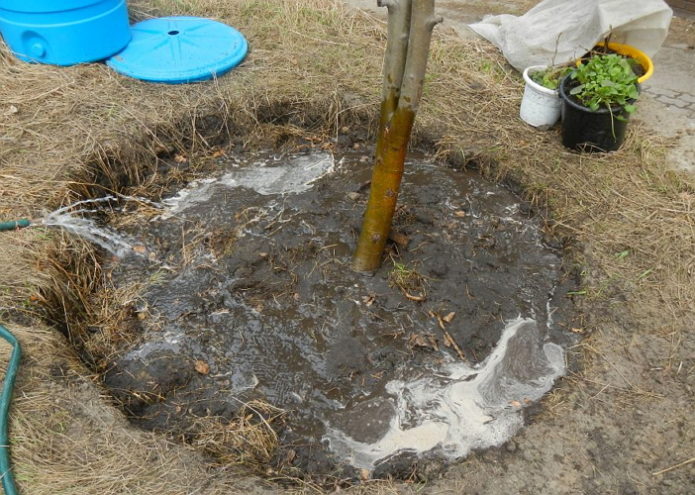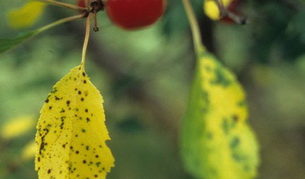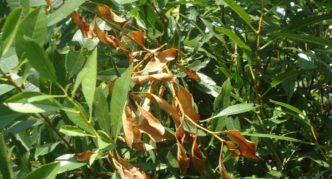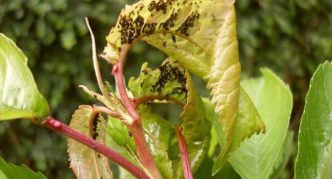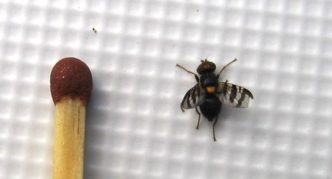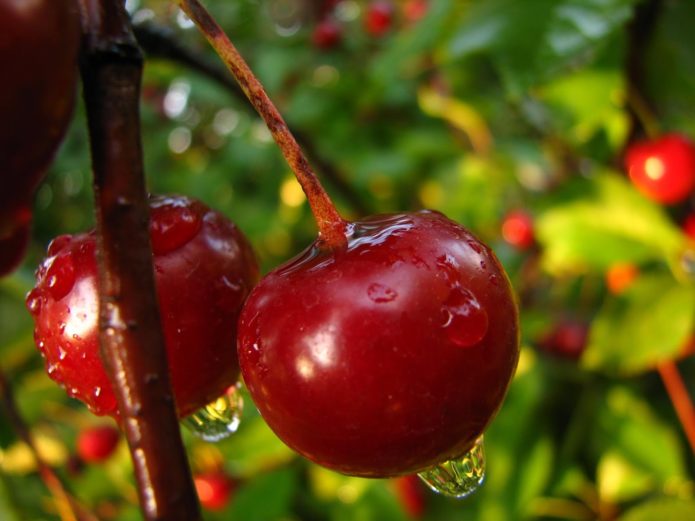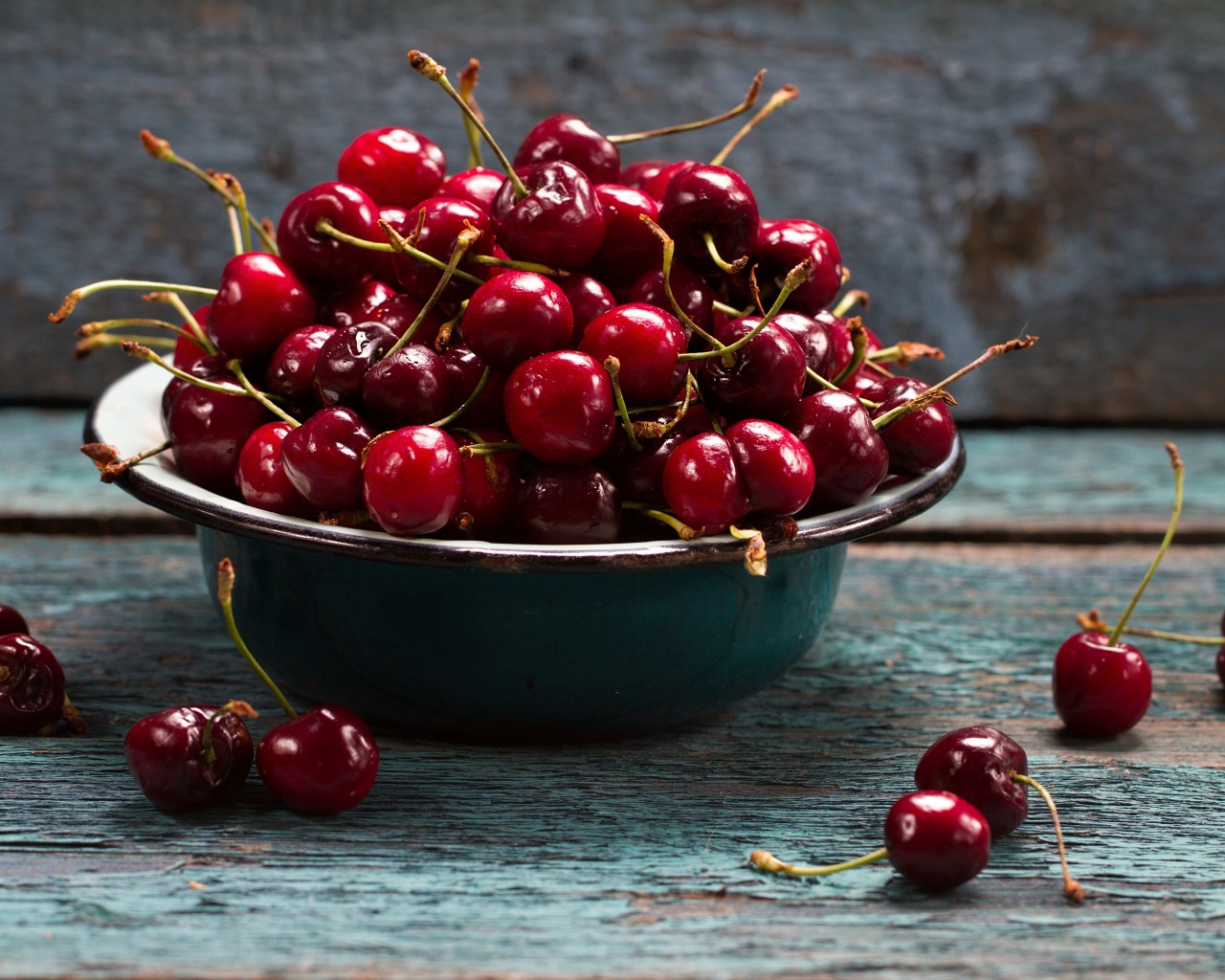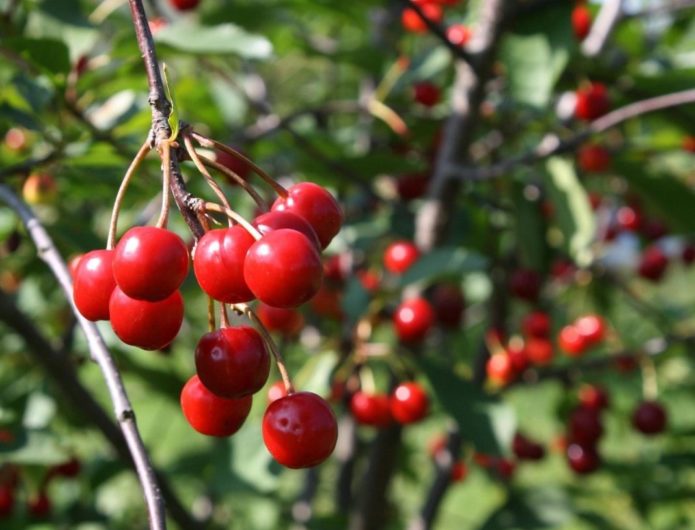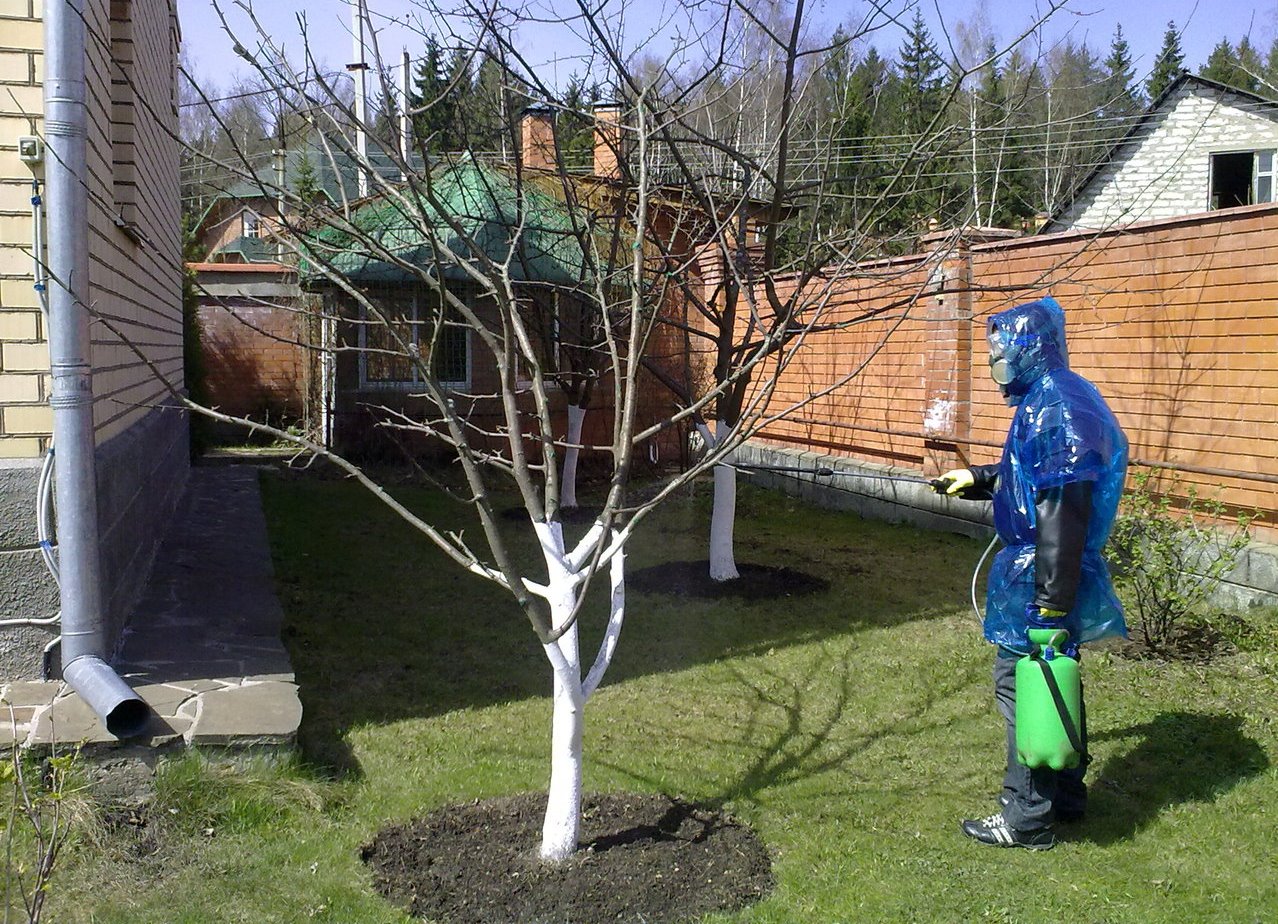Cherry is a berry loved by many. Therefore, many varieties of this culture are considered "folk". Among them is Blackcork. She enjoys well-deserved respect among gardeners. Tasty, aromatic and large fruits, ease of care and good frost resistance are the advantages thanks to which the variety has become popular.
Content
History and description of Chernokork cherry
The variety appeared in Ukraine. Since the mid-70s of the XX century, it has been zoned in almost all regions of the country. In Russia, Chernokorka successfully grows up in the Rostov region and Krasnodar Territory.
Blackcork is a bushy tree. The size is medium, the maximum height is up to 3 m. The crown is flat-round, with slightly drooping branches. Average leafiness.
The berries look very attractive on the outside. They are large in size, weighing from 4 to 5 g. Rounded in shape, painted in a dark burgundy color, fully ripe - almost black. Subcutaneous points appear through the thin, shiny skin. The peduncle is more than medium in length, strong. It holds the ripe fruit well. But the separation from the berries is wet. The stone, which occupies no more than 7% of the total mass of the cherry, separates from the pulp quite easily.
The flesh of Chernokorka is dark burgundy, dense, very juicy. It has a refreshing taste with a predominance of sweetness. The juice is deep red. Tasters' assessment - 4.2 points out of 5.
Characteristics of the variety
- The berries ripen by the end of June - beginning of July, here the weather can make its own adjustments. Ripe fruits do not crumble.
- The variety has an average maturity. The seedling will be able to bear fruit only after 4, or even 5 years.
- Chernokorka can be safely called a high-yielding variety. Average indicators - 30 kg per tree. If the cherry is grown in favorable conditions, the number of fruits doubles. But with age, yields can decline. In addition, there is a periodicity in fruiting.
- In the growing regions for which the variety is zoned, the tree shows high winter hardiness. In addition, cherries can handle the absence of rain and high temperatures quite well.
- As for immunity, there is a rather high susceptibility to coccomycosis, which is especially manifested during periods of high humidity.
- Chernokorka cherry blossoming in medium terms needs pollinators, as it is a self-fertile variety.
Table: advantages and disadvantages
| Advantages | disadvantages |
| Large-fruited and great taste of berries. | The variety needs pollinators. |
| High winter hardiness in growing areas. | Low resistance to fungal diseases, especially coccomycosis. |
| Ability to tolerate drought. | |
| Ripe fruits do not crumble. | |
| High productivity. |
Landing rules
These simple rules determine how the cherry will form in the future. If you comply with all the norms, the Blackcork will quickly develop into a healthy tree and bear fruit on time.
Sapling selection
Choosing the right seedling is an important process. The future health and productivity of the tree depends on it. Examine the tree you like very carefully. The main assessment criteria should be reduced to the following points:
- Sapling age. The best survival rate is shown by 1–2-year-old trees from 1 m in height.
- The trunk should be straight. The bark is whole, elastic, without any damage or traces of disease. Slightly scratched canopy will expose bright green wood, indicating the viability of the planting stock.
- Branching. A 1-year-old seedling has no branching, but buds should be located on the surface of the stem, from which shoots will develop in the future. A 2-year-old tree has at least 3 branches.
- A healthy and branched root system is the key to quick survival of the seedling. The presence of torn, rotten, or swollen areas indicates possible disease or careless digging, which damaged the roots. This can negatively affect the adaptation of the planting material.
If you are purchasing a seedling with closed roots, also carefully examine the bole, bark and branches. To assess the condition of the root system, tilt the pot and inspect the roots protruding from the drainage holes. They should be elastic, light on the cut. If the plant is pulled out of the container, the earthy clod should not decay.
Purchase only zoned planting material. This can be done in special nurseries or from reputable vendors.
The best time to buy a seedling is autumn. During this period, the richest selection of trees and a reasonable price.
When to land
Optimal terms:
- in autumn: in the southern regions, planting is carried out from October to mid-November. In a temperate continental climate, the dates are shifted to late September - early October;
- in spring: as soon as the snow cover melts and the ground warms up enough. This happens in April - at the beginning or in the middle, depending on the region. But you definitely need to be in time while the buds of the seedling are at rest.
If you purchased a seedling in the fall, but did not manage to plant it, do not worry. Until spring, the tree can be perfectly preserved in a buried state. To do this, find a secluded corner in the garden, protected from the freezing wind. Dig a ditch 40-50 cm deep, place a seedling in it at an angle of 45about... The top of the tree should face south. Cover the trunk and bases of the skeletal twigs with earth, tamp lightly and water. In winter, so that frosts can not harm the roots, you can warm up a large snowdrift. And if the winter is snowless, the roots can be covered with an additional layer of earth.
Choosing a place for cherries
Due to Chernokorka's dislike of transplants, the place for permanent placement of cherries must be chosen correctly. First of all, you need to take into account the requirements of the tree:
- First of all, it is an abundance of sunlight. Cherries growing in the shade will bear small and sour berries. And ripened in the sun - much sweeter and larger.
- Secondly, cherries are thermophilic. Despite the declared ability to tolerate the cold period well, the plant does not like heavily ventilated areas. The cold winter wind can dry out the wood tissue and lead to frostbite. Therefore, the place for cherries should be closed on the north side by a fence or building. It is not necessary to plant the plant in pits and lowlands.Cold air accumulating there can harm flowers and scare away bees.
- Thirdly, cherry loves space. In the close environment of other trees, the seedling will experience a deficiency of moisture and nutrients, which will adversely affect its development, and later on the quality of the crop.
Before planting, the acidity of the soil should be determined in advance. Cherries will hurt in acidified areas, so lime or dolomite flour must be added to the soil for digging. On earth with high acidity, this procedure will need to be carried out regularly.
Cherry puts forward the following requirements to the soil - light in structure, nutritious and loose, capable of easily passing moisture and air. In the regions where Chernokorka grows, typical black soils meet these requirements. It will also grow well on loam and sandy loam.
Heavy clay soil hinders the growth of cherries. It is cold and prone to moisture accumulation. These factors adversely affect the general condition of the tree.
So that the roots do not suffer from stagnant moisture, the groundwater level should pass no higher than 1.5 m to the soil surface.

In an area with a high location of groundwater, drainage channels should be dug before planting a seedling
Site preparation for planting
You need to prepare a place before planting cherries in advance. The selected area is cleared of plant debris, perennial roots and stones. It is a good idea to sow the site with green manure a year before planting, and then embed them in the soil when digging.
For an autumn planting in the spring, dig up the selected place on the bayonet of a shovel, having previously scattered organic and mineral fertilizing over the surface of the earth. 1 m2 area you need to add:
- 10 kg of well-rotted manure;
- 100 g of phosphorus and potash fertilizers.
If the site contains a lot of clay, then applying a large amount of coarse sand will help give the soil the necessary looseness and increase aeration. A planting hole in clay and stony soils is dug larger (20% of the standard) so that the root system has enough space for normal development.
Peat applied to sandy soil will help retain moisture in soil that is too dry. In addition, the sandstone requires a little more fertilization than it should be.
Landing pit
A month before planting in autumn, dig a hole that matches the size of the seedling's root system. Standard volume: diameter - 70 cm, depth - 60 cm.
- Spread the earth from the pit on two sides. In one - fertile soil from the upper layer, in the other - raised from the lower area.
- Add a bucket of humus and 1 liter of ash to the fertile soil. If the preparatory work on the site was not carried out, then apply potassium-phosphorus fertilizers. Stir the mixture thoroughly.
- Drive a 1.5 m high stake into the solid bottom of the pit.
- Return the prepared soil mixture back to the pit.
- Moisten the soil to obtain the required density.
For spring planting, the pit should be prepared in autumn, in October.
Step-by-step planting process
- Before planting, the roots of the seedling can be dipped in a bucket of water for several hours.
- During this time, remove part of the soil from the pit, and arrange the rest in the form of a slide.
- Place the tree in the center of the mound. Spread the roots so that they are directed downwards and lie without twists and creases.
- Return part of the soil removed from the pit. In this case, the seedling can be shaken slightly to help the soil mixture fill in any voids in the roots.
- After planting, lightly compact the soil around the trunk and in the root area.
- Tie the stem to the support.
- Form the rim of the watering circle from the ground. Pour 2 buckets of water into it.
- After the moisture has been absorbed, assess the fit. The root collar should rise 3–6 cm above the surface.If it is too high, top up the soil to the desired level.
Pollinators
When preparing for planting the Blackbird, make sure to pair with her neighbors blooming at the same time. This is necessary to improve the quality and quantity of the crop. The Lyubskaya cherry will perfectly cope with this task. In addition to her, numerous varieties of cherries can take part in the pollination process - Aelita, Yaroslavna, Donchanka, Lesya, Annushka, Early pink, Drogana yellow, Donskaya beauty.
Video: planting cherries and caring for them
Care requirements
The unpretentious Chernokorka cherry, like other fruit trees, needs proper care.
Watering
Chernokorka was born in Ukraine, where dry weather prevails in most regions in summer. Therefore, at the genetic level, the variety tolerates drought well. But you cannot completely leave the cherry without watering, this can result in a loss of harvest. Watering is especially important during the following periods:
- when flowering ends and the ovary begins to form;
- during the fruiting period, simultaneously with which the buds of the next year's harvest are laid.
Proper watering is very important for the tree. The main rule is to deeply moisten the soil, up to 40-50 cm. This will require 4 to 5 buckets of water.
Watering features:
- the process is best broken down into 2 stages - morning and evening, pouring half of the water norm into each;
- so that the liquid does not spread over the surface, but concentrates in the root zone, form a watering circle;
- water must be poured slowly so that it has time to be absorbed;
- 2 weeks before harvesting, humidification is stopped;
- if autumn does not indulge in precipitation, cherries must be watered abundantly. Thus, the root system is saturated with moisture, which will enter the tissue of the tree. This will help the cherry to cope with frost without damaging the wood.
The seedling watering mode is different. For the roots of a young cherry to develop quickly, it needs frequent hydration.... Watering is carried out weekly. It is enough to pour 1 bucket of water under the tree. But you should take into account precipitation. Excessive soil moisture will not benefit cherries. After watering, be sure to mulch the tree trunk circle. This will not only help conserve moisture in the ground, but it will also prevent weeds from growing.
Pruning
Bush-like cherries need pruning no less than others. The fact is that this type of tree bears fruit only on the shoots of the last year. In this regard, there is an annual displacement of the fruiting zone to the periphery, and the inner part of the bush is more like a ball of intertwined bare branches. Therefore, thinning pruning is the main operation in the crown formation process.
Rules for pruning bush-type cherries:
- A crown of this type should consist of more skeletal branches than a tree branch. Therefore, during the formation process, you must leave at least 5 branches.
- With proper care in the first years of fruiting, it is not necessary to remove shoots.
- In the future, the growth of shoots slows down, many long bare branches appear, which do not yield a crop, but only draw off nutrients. In this case, the shoots are shortened by 1/3 or half the length. This starts the branching mechanism.
- Long shoots growing deep inside the crown are cut into a ring.
- It's not worth working with skeletal and semi-skeletal branches in one year. Prune them one by one, after a year, so as not to reduce the yield.
- In the fall and spring, sanitize pruning as needed by removing broken or diseased branches.
Top dressing
The introduction of nutrients at the preparatory stage relieves the need to fertilize cherries within 2 years after planting. From the 3rd year of life, organic matter and mineral fertilizers should be applied regularly, especially after the entry of Chernokorka into the fruiting period.
Experienced gardeners know that seasonal top dressing of cherries is the most effective, which allows you to add nutrients exactly when there is a real need for them.
- Spring. Spring feeding of cherries is the most important stage of care. If nitrogen-containing fertilizers are not applied in time, it is difficult to count on a healthy appearance and a good harvest. In March, ammonium nitrate or urea is introduced at the rate of 60–70 g per 1 adult tree. This is done by digging, sprinkling the prescribed amount of fertilizer in the trunk circle. If the snow hasn't melted yet, it doesn't matter. The top dressing scattered over the snow will be used as soon as the snow begins to melt. Instead of mineral fertilizer, you can use organic, in particular, chicken manure. 1 part of fertilizer is mixed with 1 part of water and infused for up to 4 days. Then it is filtered and diluted 1:10. It is necessary to use such a solution only after watering, so as not to burn the roots.
- Summer. Having carefully examined the tree, you can determine by its appearance which microelements are lacking in the soil:
- yellowing of young leaves means a lack of iron and manganese;
- if old leaves turn yellow, there is a deficiency of magnesium, zinc, potassium and nitrogen in the soil;
- stretching of leaves or loss of color may indicate a lack of nitrogen;
- poor root growth, stiffness and fragility of shoots, stunted leaves will let you know that the cherry needs phosphorus. All these trace elements can be given in the form of foliar feeding, which should be carried out only in the evening or early in the morning.
- Autumn. During this period, the cherry has already borne fruit, it does not need to spend energy on growth. On the contrary, the tree must prepare for winter. Superphosphate (80 g), ash (1 l) and potassium (30 g), introduced under the crown with subsequent digging, will help in this.
Nitrogen-containing fertilizers that cause shoots are not involved in autumn feeding.
Autumn work and preparation for winter
Autumn gardening will help the cherry enter a dormant period and survive it safely. Falling leaves from a tree should serve as a signal to start work:
- clean the tree-trunk circle of fallen leaves. If the cherries are healthy, then they can be sent to the compost heap. Leaves from a diseased tree must be burned, as they conceal pathogens in themselves;
- if mummified fruits remain on the cherry, they must be collected and also burned;
- clean the stems from lichens, exfoliated bark. Treat problem areas with a solution of copper sulfate and seal the wounds with garden varnish. Do not forget to whitewash the trunks;
- it is advisable to carry out sanitary pruning before the onset of frost, so that the tree has enough time to heal wounds;
- if the fall is very dry, be sure to water the tree well. A dehydrated plant can dry out from frost and wind. This is especially true for annual increments;
- spray the crown of the cherry and the trunk circle with Bordeaux liquid or copper sulfate. This is an excellent prevention of diseases and pests.
Wrap the stems and skeletal branches of the young Blackcork with covering material. Anyone, the main thing is that it does not interfere with the penetration of air to the bark. Be sure to insulate the root zone with manure. But this should be done only when the processes of sap flow have stopped in the tree, otherwise nutrients can provoke unnecessary growth of shoots.
Adult Blackcork tolerates frost well. Unlike a young tree, it does not need insulating the trunk. But the roots must be covered, especially around the perimeter, where the suction roots are located.
Diseases and pests
Chernokorka's weak point is her susceptibility to fungal infections.This primarily applies to trees to which the wrong agricultural technology was applied. Weakened cherries are also vulnerable to pests.
Table: possible diseases and pests
| Diseases and pests | Symptoms | Control measures | Prevention |
| Coccomycosis | The fungal infection causes the leaves to turn yellow and have small reddish-brown spots on them. Overgrown spots dry out, and the affected tissue crumbles, leaving holes on the leaves. Premature leaf fall begins. The fruits become small and lose their juiciness. A diseased tree may not survive the winter. |
|
|
| Monilial burn | In damp weather, buds and shoots begin to dry out suddenly. Fruits become smaller and deformed. In the advanced stage, cracks can form on the bark, from which resin begins to stand out. |
|
|
| Cherry aphid | Aphids can cause great harm to young trees. A colony of small insects settles, as a rule, on the back of a leaf or young shoots. By sucking out the cell sap, the pest leads to deformation of the foliage and drying out of the shoots. Cherry weakens, becomes vulnerable to disease, does not tolerate frost. | To combat aphids, Actellik, Iskra, Fitoverm are used. Processing is carried out before flowering. Good results are obtained by alternating drugs. |
|
| Cherry fly | The pest lays eggs inside the fetus. The larva eats the berry from the inside. Affected fruits darken, the pulp softens, rots. Cherries quickly crumble. |
|
|
Photo gallery: how to recognize diseases and pests
- Coccomycosis leads to early leaf fall
- Cherries affected by monilial burn look burnt
- The cherry aphid weakens the tree, its leaves become deformed, and the shoots dry out
- Cherry fly and its larva can destroy most of the crop
How to harvest and preserve crops
You need to start harvesting cherries from the lightest side. This is where the berries ripen earlier. Harvesting should only be done in dry weather in the morning or evening. If it rained the day before, it is better to wait, allowing the berries to dry out. Wet fruit will spoil very quickly. Ripe Blackcork does not crumble, so you don't have to worry about losing your harvest.
This cherry has a wet tear, which can make picking a little difficult.If you tear off a berry without a tail, it will deteriorate very quickly, so this method is only suitable for urgently eating juicy cherries or processing. In order for the cherry to lie in the refrigerator for several days without damage, it must be plucked with a tail. You can use scissors to cut off half of the stem. Thus, both branches and fruits will remain intact. The plucked whole cherries are immediately placed in small containers that have ventilation holes in order to exclude mold.
Cherry Chernokorka is a universal berry. Many delicacies can be prepared from it: delicious and aromatic jam, thick jam, cherries in their own juice, compote. Packed in cellophane bags and frozen fruits can be stored for a long time.
Reviews about Chernokork cherry
Probably, there is no need to talk about Chernokorka - it is good in flowering and has no equal in fruit. I don’t know how this cherry variety is culturally called - but we call it “black cork”, its cherries ripen late, but they are sweet, large and so dark that they are almost black. This is my favorite variety. But what is bad - it is not always productive and the tree is large.
I also have a Chernokorka growing, a super cherry. It goes both fresh and in the blanks. As for the taste, it may depend on the region.
We hold Chernokorka in high esteem, and for compote, and for dumplings, and for pies, for canning, everywhere you can. Large, sweet, even so to eat.
If an unpretentious and prolific Chernokorka settles in your garden, then with proper care you will become the happy owner of a tasty and healthy harvest. Natural sweet berries will strengthen the immune system, and cherry preparations will diversify the winter menu.
